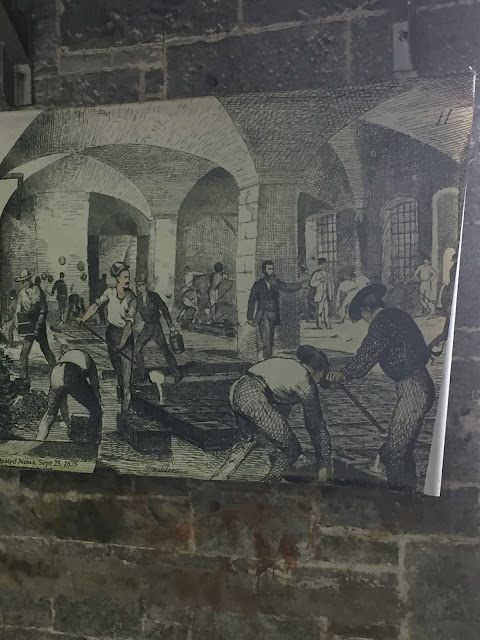Last week I had the opportunity to tour the Kingston Penitentiary, a former maximum security prison on the shores of Lake Ontario in Kingston, Ontario. It opened in 1835 and operated until 2013.
We had the opportunity to have a 'mug shot' taken in the waiting area before the tour. We were required to sign waivers absolving the institution and Correctional Service Canada (CSC) from any liability during the tour.
We were in a group of 24. Our tour guides were knowledgeable university students. They took us to various stations around the prison where, in some cases, former employees would talk about what their job was and what the conditions were like. They would also take any questions except any dealing with any specific inmates.
Originally the cells were only 27" wide. This was an example of that - taken at the Penitentiary Museum across the street.
However, in the first renovation in 1895, walls were removed between pairs of cells more than doubling their width (the wall that was removed was at least 8" thick).
In the 1992 renovation, a molded plastic desk/bed was created and shelves with removable bins.
This was an example of a wheelchair-accessible cell, where they had simply removed yet another wall, making space for a lower bed
with a desk and toilet facilities on the other side.
We then toured the segregation unit or 'the hole'. I was surprised to see that there were windows.
This cell was for inmates on suicide watch.
Outside as we walked between buildings
we saw the dates of the construction and major renovation that took place.
There are about 7 or 8 family 'cottages' where family visits over a weekend could take place. There were one, two, and three bedroom cottages. It looked like a line of motel rooms. Prisoners could earn the right for overnight family visits and had to go through an extensive request process.
We were taken into the workshop area. There was a photo of one of the 1954 riot that took place where much of the workshop area was destroyed by fire. In the workshop they made mattresses, and Canada Post delivery bags. We learned that license plates were made in provincial jails, not here - a federal penitentiary.
Here, Marilyn is looking at pairs of footprints were painted on the floor to show inmates where to stand before being frisked for contraband after leaving the workshops.
The interior of the workshops had brick ceilings which were made to support heavy equipment in the floor above.
This image shows what the workshop looked like 150 years ago
Inmates had to earn the right to work in the workshop. The prison itself and most of the renovations were done by inmates - which provided cheap labour for the Government of Canada and gave the inmates purposeful work.
Charles Dickens even visited the prison in 1842 and commented in his American Notes, "There is an admirable gaol here, well and wisely governed, and excellently regulated, in every respect. The men were employed as shoemakers, ropemakers, blacksmiths, tailors, carpenters, and stonecutters; and in building a new prison, which was pretty far advanced towards completion. The female prisoners were occupied in needlework".
Outside in the 'recreation area', we could see the observation towers and razor wire. In spite of that, there were several breakouts over the years.
It's all covered with loose gravel now. The cloudy skies added to the gloomy feel of the place.
Across the street, was the Penitentiary Museum, formerly a grand residence of one of the officials from the Pen. There is a voluntary donation to tour it. The building behind it is the old women's prison.
Inside, we viewed lots of interesting and creepy artifacts. Here Janett is posing beside what they called the ''Water Bath Punishment" device where the inmate would be stripped naked and seated with hands locked into the stocks. Their head would then be locked into the smaller barrel which had a hole in the top. Water would then be drained from the upper barrel into the lower one. A modern day water-boarding technique.
This practice had been instituted in the 1840s in the Auburn NY prison as a substitute for 'the lash'. Its use in Kingston was discontinued in 1859 "in consequence of ascertaining that it had a fatal effect in the prison at Auburn NY".
In the museum was also an example of a furnished cell. On the tour we were told that inmates were not given TVs or other amenities, they were all earned.
I guess Canadian taxpayers needed to be assured that the inmates weren't just kicking back and enjoying their time of relaxation in the 'pen'.
This was an example of one of the wash basins that were installed in the renovation of 1895 and were removed after the riot of 1971.
There were displays of handcuffs and leg irons over the generations and a big showcase full of 'contraband' - mostly 'shivs' fashioned out of toothbrushes and whatever else the inmates could get their hands on, self-tattoo kits, other punishment devices, whipping posts, punishment books, Corrections Canada uniforms from various decades, etc. etc.
It was a very interesting tour and not one that will be available indefinitely as the historical building is the subject of review for future development. I'm glad we took this opportunity to tour this historic site.






















No comments:
Post a Comment